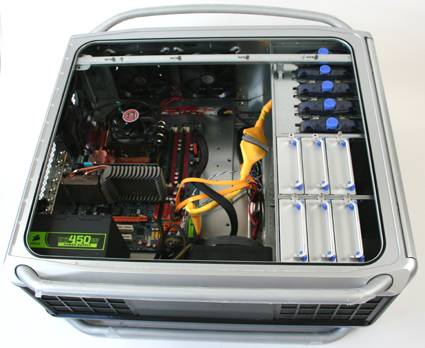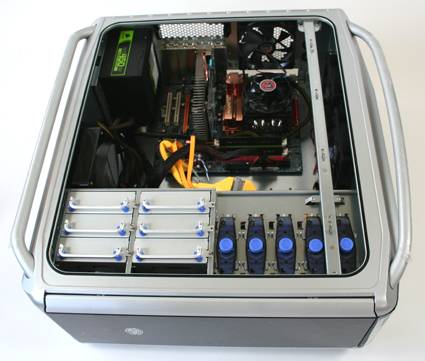Can CPUs Make PCs Faster & Quieter?
Build 2, Continued
This build was also relatively straightforward to assemble, because our only real issues came from finding a suitable cooler, and we solved those problems before we tacked the motherboard down inside the case. The bigger full-size ATX motherboard gave us more room to maneuver. It also offered multiple PCI-e x1 slots so that you can install a double-wide graphics card like the Gigabyte GV-NX86S256H without removing that type of slot from use (on the N4L-VM motherboard, this graphics card made the x1 slot inaccessible, and will require us to use a different SDTV-HDTV combo card in an upcoming build).
From the bottom of the case, looking toward the top, you can see the dual exhaust fans at the top, and the larger GA-P35T-DQ6 motherboard at the mid-left.
From the front of the case, looking toward the back, you can see the giant heat sink to the left of the CPU cooler, the port block behind the CPU cooler and the memory in front, all of which fence things in tightly.
Power consumption on this build was significantly higher than the T7600 build, according to the Seasonic Power Angel we used to monitor consumption. During bootup, the system consumed between 187 and 204 watts, then settled to 131-143 W at idle. Peak power consumption during our most intense benchmarks (3DMark05) went no higher than during booting (204 W).
As built, the total cost for the QX6800 system comes to $3,018 or thereabouts. The QX 6800 contributes heavily to that cost (the best price we could find was $1,039), as does the DDR3 RAM we chose ($565) and the HD-DVD player ($339). Even the motherboard ($255) adds real cost to this build. Switching to a DDR2 motherboard such as the P35-DQ6 cuts $30 from those costs, and lets you use the same memory we used in the other build ($335). Switching the HD-DVD out for a conventional DVD burner saves another $300, and only you can decide if you really want to spend over one grand for a CPU. You can get good results from an Intel Core 2 Duo E6700 ($312), though, and save another $700. Judicious trimming on system components can reduce costs over $1,000.
Get Tom's Hardware's best news and in-depth reviews, straight to your inbox.
Current page: Build 2, Continued
Prev Page Build 2: Intel Quad Core 6800 Processor (QX 6800) Next Page How (and What) We Tested
